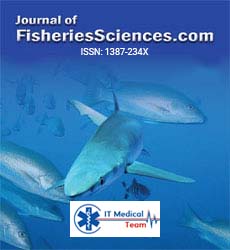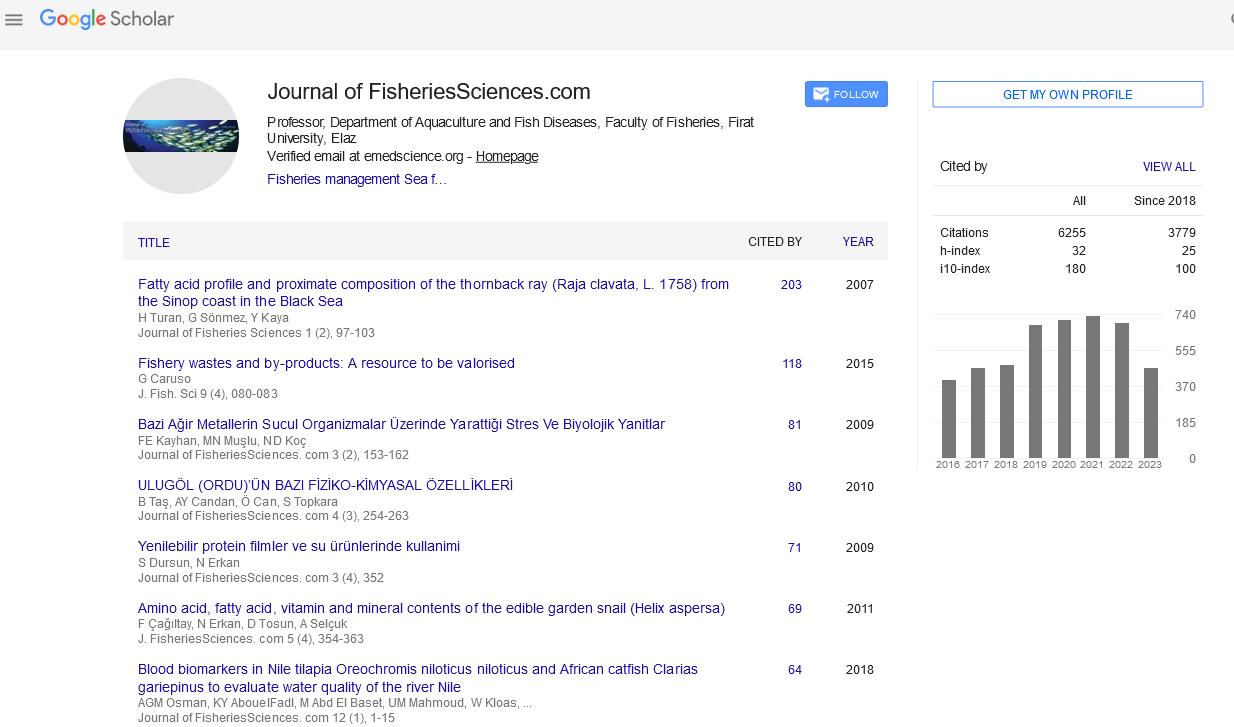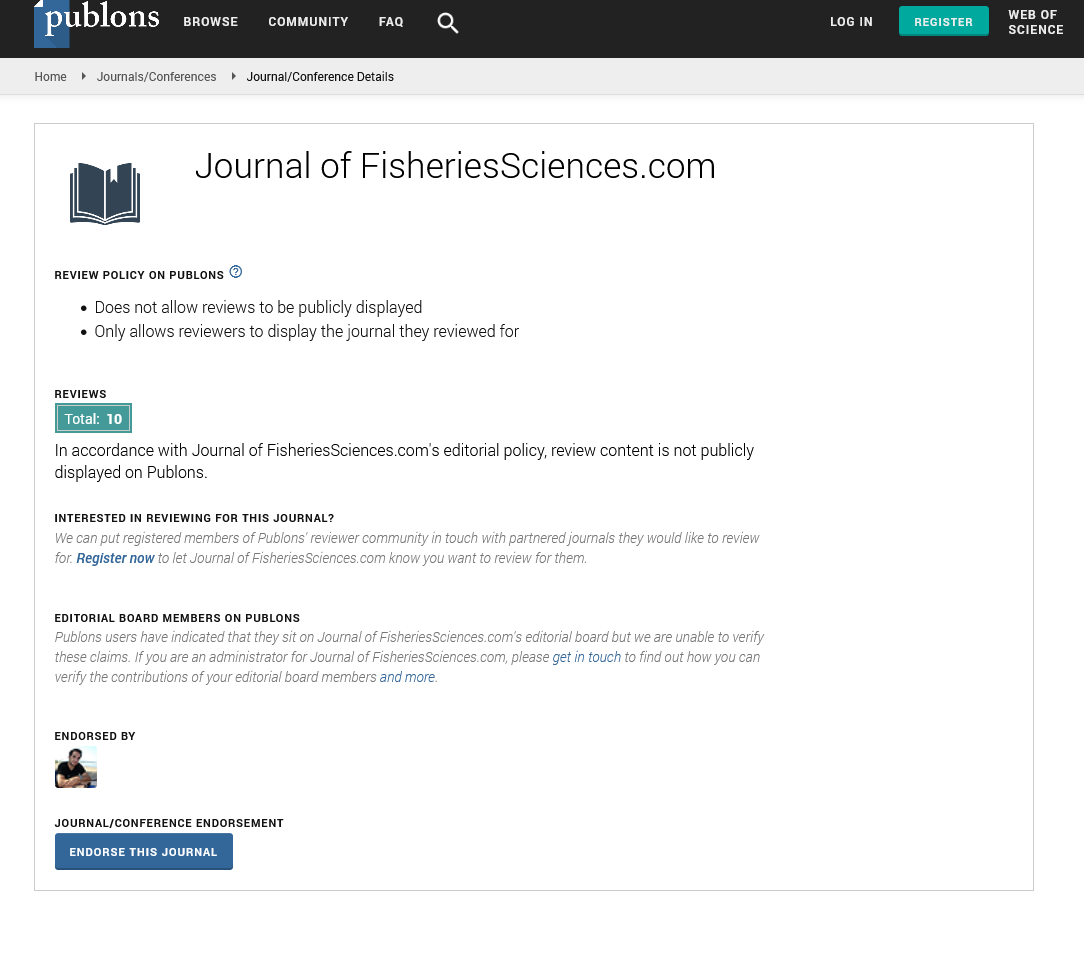Research Article - (2023) Volume 17, Issue 5
Tuna fish market in the Androth Island, UT of Lakshadweep, India: A field study
Rekha Govindan1* and
Najva AI2
1Department of Aquaculture, Govt College of Arts and Science, Andrott, Lakshadweep, India
2Department of Aquaculture, PM Sayeed Calicut University Centre, Andrott, Lakshadweep, India
*Correspondence:
Rekha Govindan, Department of Aquaculture, Govt College of Arts and Science, Andrott, Lakshadweep,
India,
Email:
Received: 24-Jun-2023, Manuscript No. IPFS-23-13860;
Editor assigned: 27-Jun-2023, Pre QC No. IPFS-23-13860 (PQ);
Reviewed: 11-Jul-2023, QC No. IPFS-23-13860;
Revised: 24-Aug-2023, Manuscript No. IPFS-23-13860 (R);
Published:
04-Sep-2023
Abstract
The Laccadivian Islands are rich in Thunnus fish species that have high market
values across different continents. Hence, Tuna fish industry is one of the major
industries in all islands of the Union Territory of Lakshadweep (UTL). Therefore,
to examine the current scenario of tuna fish industry, a field study on different
attributes of tuna fishing and trading in the Androth Island of UTL was performed.
A morning fish market located in the Eastern side of Androth Island, UTL was
selected as the field of study.
The fishermen of Androth jetty fish market participated in the field study. Details
regarding Tuna landings were collected from the fishermen. The field study
identified that fishing and trading is done for raw tuna fish as well as dry tuna fish
forms. House hold tuna consumption and local tuna based food markets resonate
well as there is high abundance of tuna species during the seasons. It can be
said that Tuna based traditional food markets are sustainable in Androth due to
converting raw tuna fish into dried form called “mass meen”. A market thus exists
for developing Tuna based sea food industry on a larger scale at Androth.
Keywords
Coastal Island; Androth; Fish market; Tuna fish industry; Union
Territory of Lakshadweep (UTL)
Introduction
Androth is one of the Coastal Islands of Lakshadweep lying on the
Arabian Sea, 220 kms–440 kms off the Kerala Coast. It lies in the
East West orientation, between 10°48’ and 10°50’ N latitude and
73°38’ and 73°42’ E longitude. Androth is the largest island of UTL
with an area of 4.90 sq, length of 4.66 km and a maximum width
of 1.23 km. It stands apart from other islands of Lakshadweep in
having a very small lagoon area and in the orientation. It is the
most populated island among the eleven inhabited islands of
Lakshadweep [1,2].
Fishing is the major industry in Androth [3,4]. Fish markets thrive
in Androth due to landings of different Tuna species and lagoon
fishes. Due to low lagoon area, the numbers of landing sites are less
when compared to other islands of Lakshadweep. There are two
major landing sites in Androth Island, one at Androth jetty area
and other at the Tharavakar junction. The present study is a field
analysis on Tuna landings and Tuna fish market existing at the jetty
area of Androth, UTL.
Materials and Methods
A questionnaire was prepared and visits were made to the Androth
fish market. Attributes of Androth tuna fish market were collected
from the fishermen (Tab. 1.). The questionnaire had different
sections A, B and C. Section A dealt with general attributes
of fishermen like age, gender, education, source of income. The
section B gave information on all fish landings (including Tuna)
and section C on attributes of the Tuna fish market in the jetty area
of Androth, UTL.
Study population
The study populations consist of male fishermen from Androth, a
coral island of the UT of Lakshadweep. All respondents are in the
age category of 30 to 50 years and fishing forms their major form
of livelihood and income generation. Majority respondents are
venturing into the sea for long years (>30 years) and a few are less
than five years. Seasoned fishermen who participated in the study
are trained on safety and security measures by the dept. of fisheries,
Androth unit. The new fishermen are yet to receive any training [5].
Majorities are boat owners and have boat with gear. The revenue
generated from landings depended upon the catch for the day.
Landings at Androth fish market
| Major attributes of the field analysis |
| S. No |
Section A |
| 1 |
Age |
| 2 |
Education level |
| 3 |
Trained |
| 4 |
Boat owner |
| 5 |
Boat gear |
| 6 |
Major source of income |
| |
Section B |
| 7 |
Time of landings |
| 8 |
Duration of landings |
| 9 |
Landing size infinite (>50,000) or finite |
| 10 |
Catch of all species |
| 11 |
Catch by Tuna species |
| 12 |
Consumption patterns |
| 13 |
Commercial landing categories large species (A, B, etc), small species (A, B, etc) |
| 14 |
First sale prices |
| |
Section C |
| 15 |
Main opportunities available in Andrott fish market |
| 16 |
Significant trends observed in Androth fish market |
| 17 |
Factors that are predicted to propel the growth of Androth fish market |
| 18 |
Factors that are expected to limit the growth of Androth fish market |
| 19 |
Opportunities for Androth fish market expansion and global reach |
| 20 |
High season months in Androth fish market |
| 21 |
Low season months in Androth fish market |
| 22 |
Common varieties of Tuna species found in Andrott fish market |
| 23 |
Unusual varieties of Tuna species found in Andrott fish market |
| 24 |
Tuna fish market size in Androth |
| 25 |
Growth rate of overall market in Androth |
Tab. 1. Attributes collected through the Questionnaire.
Results and Discussion
Landings are mostly done after fishing for an average duration of
6 hours. Some landings are done after 12 hours in the sea with
different time gaps. It was reported that the catch is most yielding
during the early time of the day (Fig. 1.). Tuna and lagoon fishes
are prominent among the catch (Fig. 2.). Landings include large Tuna fishes (Yellowfin and Bluefin tunas) and small Tuna fishes
(Skipjack), Lagoon fishes (reef fish, rainbow runner, seer fish, and
sail fish) and octopus. Skipjack is the most occurring among the
Tuna species caught. Normally target landings are achieved
during the monsoon when the fish numbers are increased due to a
favorable productive time.
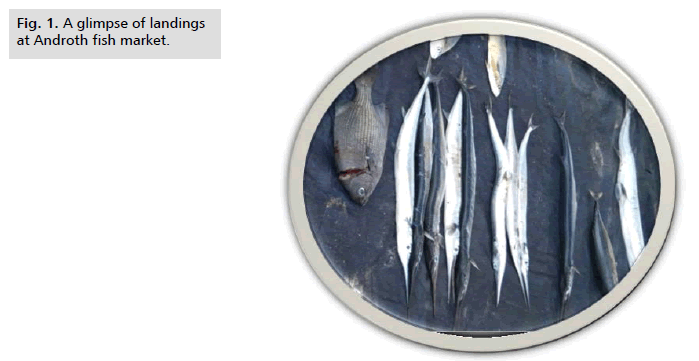
Figure 1: A glimpse of landings
at Androth fish market.
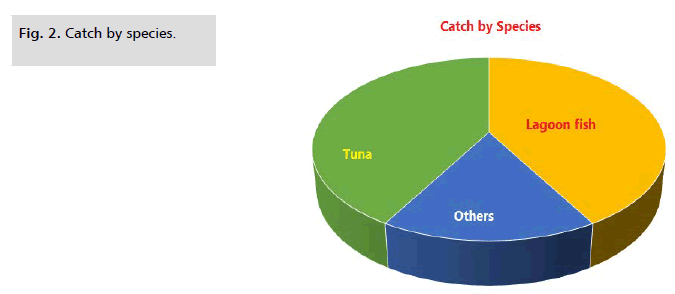
Figure 2: Catch by species.
Trading at Androth fish market
Majority of the fisherman are also traders. The fish is traded in
raw form and given to customers after cleaning and cutting
(customer friendly). Domestic consumption of Tuna is as cooked
Tuna curry and fried. Dry fish market is mainly Tuna based and
depends on the availability of Tuna fish and mass production. For
preparing “mass”, fresh Tuna fish is taken and the abdomen region
is processed by removing head, tail and gut content. The fish is cut into pieces, washed and cooked in brine for 2 hours. Smoking is
performed over the brined tuna for 2 to 3 hours using smoke from
burning coconut husks (Thondu). This is an important process
to help preserve the fish as the smoke delivers an acidic coating
onto its skin surface. This coating prevents oxidation and slows
the growth of bacteria, which in turn slows the decomposition of
fish. The smoked fish is sun dried and stored in containers as mass
meen (Fig. 3.).
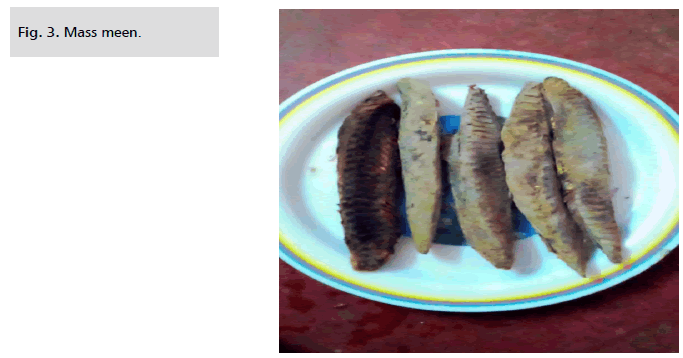
Figure 3: Mass meen.
Tuna mass based food market
Mass produced is mostly consumed during the off season when
fresh tuna availability is limited in the island and also in preparing traditional mass-based dishes of Androth (Tab. 2.). In Androth
Island, the mass production is low on an industrial scale, though it
is made in individual families where the mass and traditional dishes
are prepared using open kitchen spaces (Fig. 4.).
| Traditional food items prepared in Androth from Tuna fish and Mass |
| Mass podichath |
| Mass appam |
| Tuna fish bowl |
| Madakkappam |
| Mass Idiyadda |
| Idichathum kanjiyum |
| Tuna fish pickle |
| Mass undakadi |
| Tuna fish kadi |
| Tuna nadan biriyani |
| Tuna kozhukatta |
| Tuna cutlet |
| Tuna samosa |
| Mass puttu |
| Massanum and orotti |
Tab. 2. Name of certain traditional food items prepared in Androth from Tuna fish & Mass for local consumption.
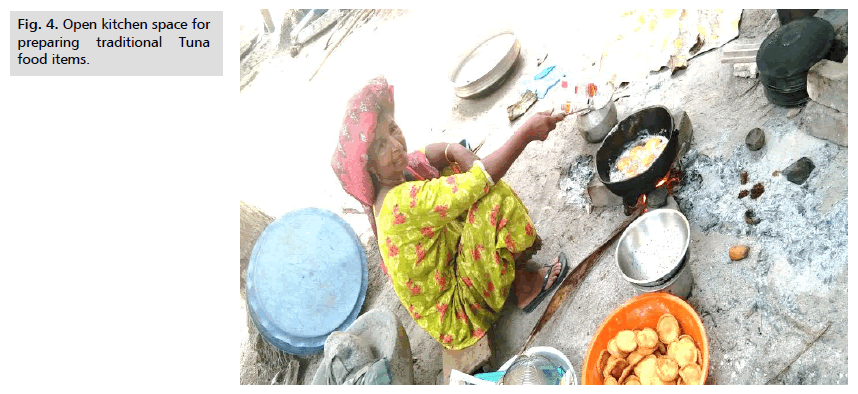
Figure 4: Open kitchen space for
preparing traditional Tuna
food items.
“Mass podichath” is made by cutting dried Tuna into small pieces
and mixed with coconut, turmeric powder, onions and garlic,
grinded into a powder form. This is consumed along with rice. For mass appam, mass and coconut gratings are mixed and are covered
with flour spread, then and cooked in oil (Fig. 5.).
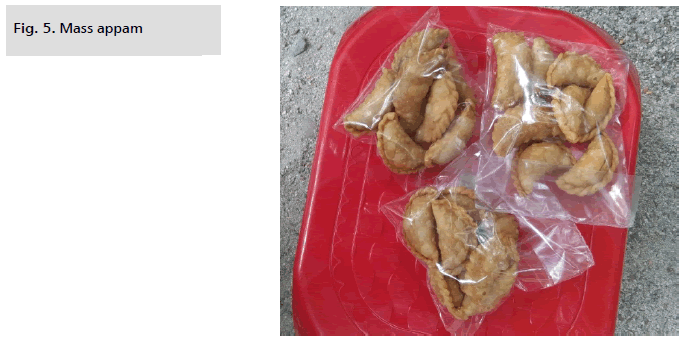
Figure 5: Mass appam
Tuna fish market in Androth
A stable Tuna fish market exists in Androth due to overall landings
and trading. Several opportunities contribute such as supply meets
demand, availability of monsoon and availability of a fish market
space (MPLAD building). However, the first sale prices often
fluctuate according to the demand and supply. Certain attributes
like fish transportation and storage facilities exist and if enhanced is
beneficial for the overall improvement in the livelihood of fishermen who are into fish trading. Fluctuations in climate, selling price, and
less tuna processing facilities are found to lower the overall revenue
generated from the Androth tuna fish market. Further, Androth
being a coastal island, subsequent COVID lockdowns and changes
in policies have slowdown the market expansion, though an
availability of more cargo from Androth fish market is expected
to accelerate the limited tuna export especially to gulf countries
[6]. Overall, the Androth fish market is now approaching into a
monsoon when the study was carried out. The yield is expected to be high compared to the off season. A favorable expansion of
Androth Tuna fish market due to the onset of monsoon is possible
with more storage and processing facilities.
Welfare measures for Androth fishermen
community
Fish markets operating in the islands of Lakshadweep are
supported by government welfare measures. In Androth, fisherman
registered with the fisheries department are provided subsidies
through Pradhan Mantri Matsya Sampada Yojana (PMMSY)
to purchase ice boxes, installation of cold storage/ ice plant and
boat upgradation to export competency. There are also awareness
classes on territorial water borders and security measures. Insurance
coverage is given to fishermen. However, some welfare schemes are
covered under “island” population throughout Androth (overall
Lakshadweep). This limits the coverage of fishermen community
from Androth under similar government welfare schemes that are
given to mainland fishermen community.
Conclusion
Androth is a coastal island belonging to the Lakshadweep
archipelago of 36 islands in the Arabian Sea. Tuna landings are
more prominent and Tuna based fish industry is one of the main
revenue generations in Androth. Therefore, the purpose of this
field study was to compile information on tuna fishing and trading
activities at the jetty fish market, in the eastern side of Androth.
The field study included visits to the fish market, interacting with
fishermen registered at the department of fisheries, Androth unit,
UTL through a questionnaire mode. The respondents of this study
were traditional fishermen, with fishing activities stretched over
long years and experienced with tuna and lagoon fish landings.
They are familiar with the fluctuations of the Tuna fish market
in Androth. They have overcome natural calamities and COVID
lockdowns over the years and strive to maintain the fishing industry
in Androth.
The major attributes of opportunities and significant trends identified in the present field study indicates a favorable tuna fish
market in Androth Island. At the same time, the limitations for
further expansion of the Androth tuna fish market and its global
reach can be overcome by the key components identified from the
field study. This field study carried out at Androth fish market is
first of its kind. The field study observed that the Tuna fish market
size and growth rate of overall market in Androth is limiting at
times. Therefore, the study concludes that this field study could
assist Androth fishermen in informing appropriate technological
assistances and govt. policies to sustain their livelihood through
Tuna based fishing industry.
Acknowledgments
This study would not have been possible without the assistance and
cooperation of a number of individuals. The authors would like to
thank all of those individuals who took part in the field study. Our
sincere thanks are in order for the Androth Fisheries department
staffs Shri. Noorul Ameen PP, In-Charge, Fisheries unit and Shri
Abdul Muasid, technical assistant for their assistance with the
design of the questionnaire and data collection. Without their able
assistance, the study would not have been possible. The authors
also wish to thank Shri Harshit Saini, DC Cum CEO, Androth
and Kalpeni Islands, UT of Lakshadweep, for his constant support
and willingness to help us overcome all problems faced. We thank
Dr. Shahul Hameed, HOD, dept. of Aquaculture, govt college of
arts and science, Androth, UTL for his assistance in carrying out
the study.
Author Contribution
Dr Rekha conceptualize and written the manuscript. Ms. Najva
contributed to methodology, investigation and resources. All the
authors read the final draft and approved the manuscript.
Disclosure
This study did not receive any specific grant from funding agencies
in the public, commercial, or not-for-profit sectors.
References
- Chandramohan P, Anand NM, Nayak BU. Shoreline dynamics of the Lakshadweep islands. Indian J Mar Sci. 1993; 22: 198–202.
[Google Scholar]
- Koya M, Koya KP, Abdul Azeez P, et al. Fishery for large pelagics in Lakshadweep. Mar Fish Infor Serv. 2021; 249: 38-40.
[Google Scholar]
- Pillai NG, Ganga U. Fishery and biology of tunas in the Indian seas. Harv Post Harv Tech Fish. 2008: 10-35.
[Google Scholar]
- Vinay A, Ramasubramanian V, Azeez PA, et al. Economic Analysis of Troll Line Fisheries in Androth, Lakshadweep. India. Int J Curr Microbiol App Sci. 2017; 6: 3172-3179.
[Google Scholar]
- Rajan R, Rajan PT, Mishra SS, et al. Fishes of Lakshadweep archipelago: New records, review and a revised checklist. Mar Biodivers Rec. 2021; 14: 1-3.
[Crossref] [Google Scholar]
- Tripathy B. Marine biodiversity of Lakshadweep: An overview. Kachappa. 2002; 7: 14-19.
[Google Scholar]
